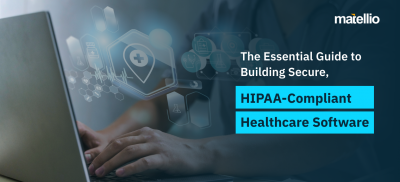
Effective crisis management requires businesses to be prepared for any eventuality, from natural disasters to industrial accidents and cyber-attacks. Leveraging emergency response software development enables organizations to respond swiftly, minimize risks, and protect critical resources and lives.
Such systems empower teams with streamlined workflows, real-time communication, and efficient resource allocation during emergencies. By automating processes and integrating advanced technologies, emergency response software enhances decision-making and operational efficiency, making it an indispensable tool in today’s unpredictable environment.
What is Emergency Response Software?
Emergency response software is a powerful digital tool designed to optimize and enhance the management of critical incidents across various industries. From natural disasters and industrial accidents to cyber-attacks and public health crises, this software equips organizations with the ability to respond swiftly and effectively, reducing risks and protecting resources.
This solution centralizes vital functions such as communication, resource allocation, and decision-making within a unified platform. It empowers teams to collaborate in real time, access accurate and actionable data, and implement pre-established emergency plans with precision. Advanced features like automated alerts, task scheduling, compliance tracking, and in-depth analytics ensure that organizations maintain control and efficiency even in high-pressure situations.
By integrating emergency management software into their operations, businesses can streamline workflows, enhance coordination, and improve their overall readiness to handle unforeseen challenges.

Source: Skyquestt
Why Does Your Business Need to Invest in Emergency Response Software Development?
Emergencies, whether natural disasters, industrial accidents, or cyber-attacks, demand swift and coordinated responses. Investing in emergency response software development enables businesses to build resilience, ensure operational continuity, and protect resources. Here are the key benefits of implementing such a solution:
 Faster Response Times
Faster Response Times
Automated workflows and real-time notifications enable businesses to act immediately, minimizing delays and reducing the risk of escalation during emergencies. Quick decision-making ensures critical actions are taken without unnecessary interruptions, safeguarding operations. Leveraging emergency response software systems, businesses can significantly reduce response times and enhance overall efficiency during crises.
 Improved Resource Management
Improved Resource Management
Real-time tracking and allocation of critical resources, such as personnel, equipment, and inventory, ensure efficient usage and availability when they are needed most. This reduces resource wastage and ensures adequate coverage for all critical areas during crises. Using emergency response plan software, organizations can optimize their resources to prevent shortages or overuse during high-pressure situations.
 Enhanced Collaboration
Enhanced Collaboration
Centralized communication platforms streamline coordination between teams, departments, and external agencies, ensuring everyone works together seamlessly during a crisis. Unified systems prevent miscommunication, enabling smoother workflows across diverse stakeholders. By adopting emergency management and response solutions, businesses can enhance collaboration and minimize operational silos during emergencies.
 Regulatory Compliance
Regulatory Compliance
Built-in compliance management features automated reporting and documentation, ensuring businesses meet industry regulations and avoid penalties during emergencies. These tools maintain detailed records, simplifying future audits and regulatory reviews. Utilizing digital transformation services can further strengthen compliance frameworks, integrating advanced tools to handle complex regulatory requirements effortlessly.
 Data-Driven Insights
Data-Driven Insights
Analytics tools provide valuable insights by analyzing past incidents, helping organizations identify inefficiencies, and improving preparedness for future emergencies. Insights allow businesses to refine their strategies, ensuring improved responses with every iteration. Implementing emergency response management software development ensures that analytics capabilities are tailored to organizational needs, offering actionable data in real time.
 Cost Efficiency
Cost Efficiency
Automation of tasks and optimized resource allocation reduce operational costs associated with manual processes, inefficiencies, and extended downtime. This leads to sustainable cost savings while maintaining high levels of operational readiness. With emergency response planning software, businesses can streamline resource management and minimize unnecessary expenditures, ensuring cost-effective operations during crises.
 Scalability
Scalability
Customizable solutions allow businesses to adapt the software to growing operational needs, ensuring long-term efficiency and the ability to handle increasingly complex emergencies. As businesses expand, the system scales effortlessly, avoiding disruptions during growth. Solutions built with emergency response management in mind ensure that scalability aligns with future challenges and evolving requirements.
Also Read: Discover how LLM in healthcare is revolutionizing patient care with advanced diagnostics, personalized treatment plans, and improved operational efficiency.
Ensure Operational Continuity with Scalable Emergency Response Software Development! Emergency response software incorporates core features to manage crises efficiently while leveraging next-gen capabilities to deliver advanced functionality. Below is a comparison of core common features and next-gen features driving innovation in this field. Add these Exclusive Next-Gen Driven Features to Your Emergency Response Software! Developing emergency response software is a strategic process that ensures the solution is tailored to meet specific organizational requirements while providing scalability and reliability. Below is a comprehensive breakdown of the steps involved, with key considerations and how our experts assist at every stage. Understanding the unique needs of your organization and identifying operational gaps is the foundation of any successful software development project. An intuitive design and well-thought-out planning ensure the software is user-friendly and meets operational demands during emergencies. The development phase focuses on building the foundational functionalities of the software to address emergency management effectively. Integrating the software with your current systems ensures seamless data flow and operational efficiency. Rigorous testing ensures the software operates reliably under real-world conditions and meets all organizational requirements. Effective deployment and comprehensive training ensure smooth implementation and user readiness. Ongoing maintenance and updates are critical to ensure the software continues to meet organizational needs and adapts to changing demands. Read More: Learn how Incident Management Software Development enhances response efficiency and ensures compliance. Emergency response software has proven to be a transformative tool across various industries, enabling effective crisis management, resource optimization, and operational continuity. Below is an in-depth exploration of its use cases, incorporating advanced features tailored to specific industry needs. Read More: Explore how Crisis Management Software Development empowers businesses to effectively handle emergencies and ensure seamless operations. This software is evolving rapidly, driven by cutting-edge technologies designed to improve functionality, adaptability, and efficiency. These advancements enable organizations to respond effectively to emergencies, ensuring preparedness and operational continuity. Here are the key trends shaping the future of emergency response software development: Artificial Intelligence (AI) is transforming emergency response by providing predictive capabilities that enhance planning and decision-making. Cloud technology has become indispensable for emergency response, offering scalability, flexibility, and remote accessibility. The Internet of Things (IoT) is revolutionizing how emergencies are monitored and managed, providing real-time insights into critical parameters. Data analytics tools are redefining how organizations evaluate and improve their emergency response strategies. As emergency response systems rely more heavily on digital tools, robust cybersecurity is essential to protect sensitive data and ensure system reliability. Want Expert Guidance for Developing Emergency Response Software? Efficient emergency response is essential for minimizing risks, protecting critical resources, and maintaining operational continuity during crises. By leveraging custom healthcare software development services for emergency response, organizations can revolutionize their approach to managing emergencies through streamlined processes, real-time decision-making, and seamless communication and resource coordination. Choosing Matellio can be advantageous: Fill out the form to explore how you can enhance your emergency response capabilities with custom software tailored to your organization’s needs. Yes, our software is designed to integrate seamlessly with tools like CRMs, communication platforms, IoT devices, and compliance systems. This ensures real-time data synchronization and a unified response framework. The cost depends on the complexity of features, integrations, and custom requirements. We provide transparent estimates tailored to your specific needs and budget. We offer comprehensive support, including 24/7 assistance, regular updates, performance monitoring, and feature optimization to keep your software running efficiently and reliably. We follow a structured approach to data migration, ensuring all critical information is securely transferred without disruptions. Our process includes planning, testing, and backup solutions to maintain data integrity. We implement advanced security protocols, including encryption, multi-factor authentication, and regular security audits, ensuring your emergency response system is secure and compliant with industry regulations.Key Features of Emergency Response Software
Core Common Features
Next-Gen Driven Features
Real-Time Alerts and Notifications
Predictive Analytics for Incident Forecasting
Resource and Inventory Management
AI-Driven Decision Support
Incident Logging and Reporting
Cloud-Based Scalability and Accessibility
Task Assignment and Workflow Automation
IoT Integration for Real-Time Monitoring
Compliance and Audit Management
Advanced Data Analytics and Visualization
Steps to Develop Emergency Response Software
Requirement Analysis
Design and Planning
Development of Core Features
Integration with Existing Systems
Testing and Validation
Deployment and Training
Post-Launch Support
Use Cases of Emergency Response Software
Healthcare
Manufacturing
Transportation and Logistics
Energy and Utilities
Public Safety
Corporate Organizations

Emerging Trends in Emergency Response Software Development
AI-Driven Predictive Analytics
Cloud-Based Scalability
IoT Integration
Advanced-Data Analytics
Enhanced Cybersecurity Measures
How Can Matellio Help with Emergency Response Software Development?
Emergency Response Software – FAQ’s
Q1. Can emergency response software integrate with existing systems?
Q2. What are the costs associated with developing emergency response software?
Q3. What kind of support and maintenance do you offer for emergency response software?
Q4. How does Matellio handle data migration during implementation?
Q5. How does Matellio ensure data security in emergency response software?
 Faster Response Times
Faster Response Times Improved Resource Management
Improved Resource Management Enhanced Collaboration
Enhanced Collaboration Regulatory Compliance
Regulatory Compliance Data-Driven Insights
Data-Driven Insights Cost Efficiency
Cost Efficiency Scalability
Scalability

